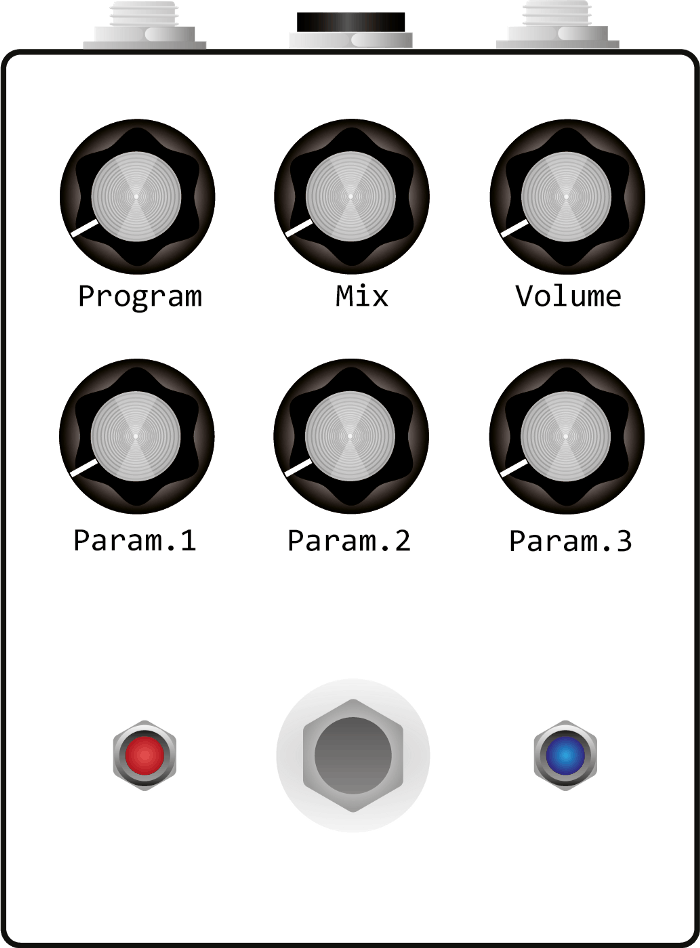I have been a bedroom music producer for almost five years and I recently got into hardware, mostly analog gear. I already own a Microbrute (monophonic analog synth) and a Drumbrute Impact (analog drum machine) from Arturia. I also built two guitar pedals with PCBs from Das Musikding (a Tube Screamer and a Fuzz factory clone). It’s a lot of fun jamming with these machines, but want more to mess with. As an electrical engineer, I believe I might be able to DIY some interesting toys.
I recently discovered a chip called the Spin Semiconductor FV-1 (SPN1001). It is described as an all-in one reverb IC with its own stereo and DAC, but can do a lot more. It seems like a good place to start : a powerful audio processor, pretty easy to use and a strong community support. My goal will be to build amulti-effect unit. So, in this first post, I’ll go over the features I want to integrate in my design. But first, some details about the chip I will be using.
The Brain
The FV-1 is basically a stereo DSP with the DAC and ADC built in. It has eight built in algorithms effects controllable with three potentiometers. However, its real strength is that you can execute eight more custom algorithms from an external EEPROM memory without the need of a microcontroller.

The instruction set for the DSP core is quite extensive and allows to design a lot differents effect such as distortions, pitch shifting, delays, reverbs and much more. Spin Semi also provides an IDE called SpinASM that allows to easily develop programs. The community also provides a lot of programs that you can use. With its pretty low cost (around 15€) and easy integration, this chip is really made to be an easy entry to the DSP world.
A digital chip ?
Even though it is a fully digital design, with a 32.768 kHz clock it should be able to achieve a 15kHz bandwidth, which should be enough for most audio application. In fact, several boutique pedal effects designers are already using this chip : Chase Bliss Audio, Red Panda, Earthquake Devices just to name a few.
What am I building ?
The idea is to build a multi-effect unit in the format of a guitar pedal.

I could easily go overboard with the features : screens, MIDI integration, CV controls, clock control … But for a first prototype I want to keep it simple. I also choose to go with a mono effect since it really simplify the design.
What I want
- Five potentiometers : Volume, Dry/Wet, and three for the program controls.
- An eight way rotary selector switch to select the program.
- An internal switch to select between internal or external EEPROM
- Two LEDs for power and clipping
- 3PDT switch to switch the multi-effect on and off
- A socketed EEPROM to easily change the external programs
- Two jack sockets : input and output
- The all thing should be powered with a standard 9V guitar pedal power supply
- And finally fit all of this in a guitar pedal style enclosure (maybe BB ?)
The challenges
Even though I’m trying to make my life as easy as possible for this first protype, there are still some challenging parts I need to figure out. First, design a working circuit and turn it into a PCB. Because the circuit will be pretty simple and there are a lot of resources online for this chip from where I can get some inspiration, I will directly go for a PCB (I know I should be doing tests on breadboard first, but what’s life if we’re not taking risks).
Even tough I already designed some PCBs, this is my first time dealing with analog audio signals and I know I should be extra careful with the noise as it could be a real problem. And in the worst case, PCBs are pretty cheap and I should be able to salvage the components if I don’t destroy them.

I already done a lot of through hole component soldering, but the FV-1 is a SOIC and will be my first time soldering SMD.
Finally, I have never worked with EEPROMs or DSPs, but I think I should be able to find the ressources to learn how to use them.
Final word
Given my Electrical Engineering background I should be able to pull this off and learn some useful skills along the way. A working unit will allow me to experiment with DSP algorithms and use it to produce cool pieces of music.
It’s also the first time I am doing a write-up like this, but I hope it motivates me to fully finish this project. I like to think this might also be useful to someone willing to build something similar, so I’ll also try to make everything open source.
The next step is designing the circuit need to interface the FV-1 chip.
